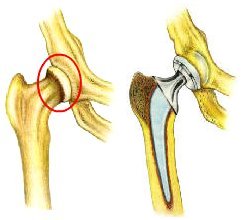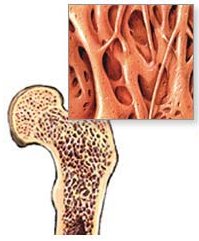|
Using space technology, researchers are developing
artificial bones for pain-free hip replacement implants.
by Steve Price and Dr Tony
Phillips
79-year-old Bob Hayes has heard all
the statistics.
There are more than 300,000 knee and
hip replacement surgeries performed each year in the United States.
Sixty-five percent of hip replacements and seventy-two percent of
knee replacements are received by people over the age of 65. Because
the U.S. population is aging, the number of hip fractures is expected
to exceed 500,000 annually by the year 2040. The average hospital
stay for a knee or hip replacement: 5 days followed by four weeks
using a walker.
Bob, a retired veterinarian from Golden,
Colorado, knows the statistics because he's one of them. Between
1978 and 1999 Bob had two hip replacements and five revisions. "I
kept three or four of them as mementos," he laughs. "I've been thinking
of using them as bookends."
Bob's sense of humour is still intact,
but the pain is no laughing matter. "You go until you can't stand
it anymore," he says, "and then you have surgery again." And again
and again.
"The problem that faces medicine today
is that the current implants last only about ten years," explains
Dr. Frank Schowengerdt, a friend of Bob's and director of the Centre
for Commercial Applications of Combustion in Space (CCACS) at the
Colorado School of Mines. (CCACS is a Commercial Space Centre managed
by NASA's Space Product Development program.) "Surgeons cut out
the old joint and glue in a new one," continues Schowengerdt. "Time
along with wear and tear cause the glue to deteriorate."

Learn
more about hip replacement surgery
from MEDLINEplus.
A normal
hip (left) and an artificial hip implant (right).
|
Bob recalls his own experiences: "The
glue would loosen and the joint would pinch a nerve. The pain was
intense."
Putting an end to that kind of suffering
is what motivates Schowengerdt and colleague Dr. John Moore. They're
working at CCACS to make better artificial bones from ceramics - implants
so much like the real thing that they could actually meld with living
bone. Such implants wouldn't come loose and need to be replaced
so often.
Most artificial bones nowadays are
made from hydroxyapatite, which has the same chemical formula as
bone itself. Synthetic hydroxyapatite, however, is neither as porous
as real bone nor as strong.
Pores are important, says Schowengerdt.
They are conduits for blood flow (blood is generated in bone marrow)
and they allow bones to be strong without being too heavy. Pores
also provide a way for living bone to attach itself permanently
to an implant. "If we get good bone growth into the pores of an
implant, then we've won," says Schowengerdt. It won't matter if
the glue comes loose 10 years later.
Researchers have also tried sea coral
as a bone substitute. "It's porous enough," says Schowengerdt, "but
it lacks strength. Sea coral is mostly used for cranial restructuring."
The solution, according to Schowengerdt,
is ceramics. He and Moore believe it's possible to synthesize ceramic
materials with the right combination of strength and inter-connected
pores to mimic real bone. Indeed they've developed a process in
their Colorado laboratory that looks promising.
"Making ceramic bones isn't like making
a ceramic coffee cup," says Schowengerdt. "The process is completely
different." Ordinary ceramics are made from powders mixed together
with a binding agent. They're baked in an oven (about 1000 C), which
evaporates the binder and leaves behind a grainy matrix stronger
than the original powders. The chemical formula remains unchanged.
Unlike coffee-cup makers, however, "we fire our ceramics at a much
higher temperature, so that the powders react to form new substances."

Learn
more from MEDLINEplus.
Living
bones are porous.
|
For example, one of the most promising
ceramics starts as a powdery mixture of calcium and phosphate compounds
(CaO and P2O5). Schowengerdt and Moore ignite
the mixture, which burns at 2600 C. CaO and P2O5
react to produce tricalcium phosphate (Ca3(PO4)2), a substance
remarkably similar (chemically) to real bone. The reaction also
yields heat and gaseous by-products that naturally form bubbly pores.
It's a good start, says
Schowengerdt,
but there's more to do. For one thing, real bones are porous (weak)
on the inside and solid (strong) on the outside. "What we've made
is like the weak interior of a bone; it doesn't yet have a strong
outer layer. We need to learn to control our process to mimic the
stratification of actual bones."
Their technique, called
self-propagating high-temperature synthesis or "SHS," is indeed
hard to control. "During the firing process, the ceramic is molten.
Gases rise and liquids sink. There's a lot of convective motion
that make the reaction unpredictable," says Schowengerdt.
"To understand this process, we really need to do our experiments
in a weightless environment where gravity-driven convection is minimized."
CCACS researchers have flown furnaces
onboard NASA's KC-135 'vomit comet' - a parabolic-flight aircraft
that provides brief periods of weightlessness. They observed dramatic
differences between ceramics prepared in normal gravity (1-g) and
those prepared in flight. For instance, the low-gravity ceramics
had larger and better-connected pores.
What happened? No one is sure because
those brief periods of weightlessness didn't allow enough time for
probing and tinkering. That's why Schowengerdt and Moore are looking
forward to March 2003, when a new materials processing facility named
"Space-DRUMSTM" (a device that holds floating molten ceramics
motionless using sound waves) is slated to be installed on the International
Space Station. By remote control from Earth and with the aid of astronauts,
they'll be able to conduct their tests in low gravity for much longer
times than ever before.
"We don't intend to mass produce ceramic bones on
the ISS," notes Schowengerdt. "That would be way too expensive.
But if we can learn more about the role of gravity in pore formation,
we might be able to duplicate our successes in space here on Earth."
Millions of people will benefit from fewer surgeries
and less pain if this research produces marketable ceramic bone
replacements. But there could be a problem: what to do with all
those obsolete implants?
Bob Hayes has an answer: "They make great bookends."
|
